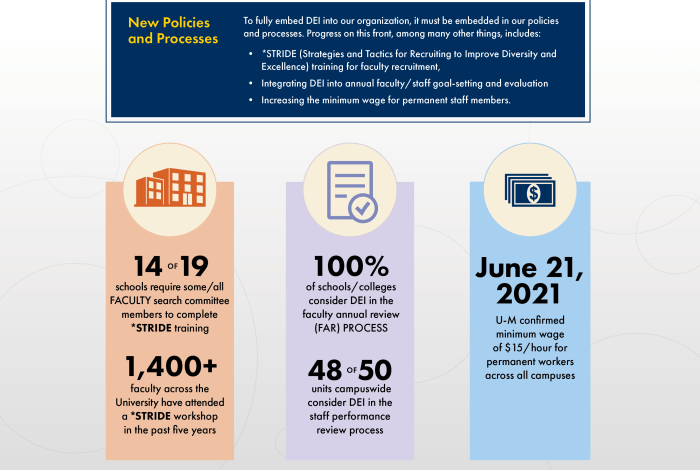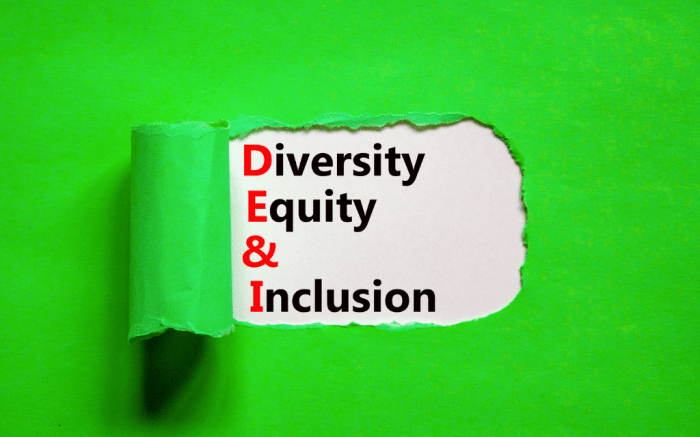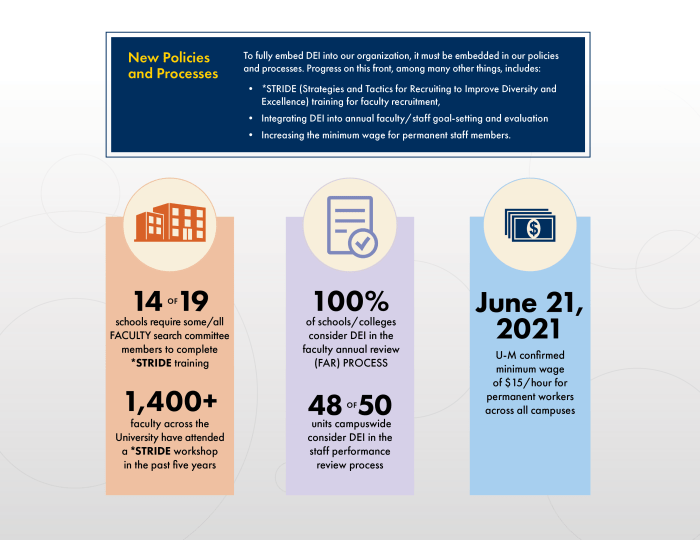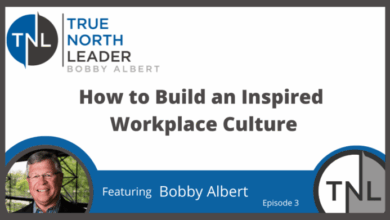
A new framework for DEI takes center stage, offering a structured approach to fostering diversity, equity, and inclusion. This framework delves into the core principles, practical implementation strategies, and crucial elements for mitigating bias. It moves beyond theoretical concepts to provide tangible steps, examples, and metrics for organizations seeking to build truly inclusive environments.
This framework explores defining DEI, analyzing elements of a new framework, outlining implementation strategies, addressing bias and discrimination, and establishing a robust evaluation and continuous improvement process. It also includes illustrative case studies to highlight successful implementations and draw valuable lessons.
Defining DEI Framework
A DEI framework is a structured approach to developing and implementing diversity, equity, and inclusion (DEI) initiatives within an organization or project. It provides a roadmap for achieving a more inclusive and equitable environment, fostering a sense of belonging for all members. This structured approach is crucial for sustainable change, ensuring DEI is not just a fleeting trend but an ingrained part of the organization’s culture and operations.A robust DEI framework goes beyond simply acknowledging diversity; it actively works to address systemic inequities and create opportunities for all.
It recognizes that diversity alone is not enough; true inclusion requires a commitment to equity and providing equitable opportunities for growth and advancement. This framework facilitates the implementation of DEI strategies and fosters a culture of respect and understanding, leading to a more engaged and productive workforce.
Key Components of a Robust DEI Framework
A strong DEI framework encompasses several key components, ensuring comprehensive and impactful change. These elements work in synergy, building upon each other to create a truly inclusive environment.
- Vision and Mission: Clearly defined statements outlining the organization’s commitment to DEI and the desired outcomes. These statements should reflect the organization’s values and aspirations, setting a clear direction for DEI efforts.
- Assessment and Data Collection: Understanding the current state of diversity, equity, and inclusion within the organization or project. This involves gathering data on representation, experiences, and perceptions of inclusivity, allowing for a targeted approach.
- Strategies and Action Plans: Specific strategies designed to address identified gaps and promote diversity, equity, and inclusion. These plans should Artikel the steps, resources, and timelines needed to implement the strategies, ensuring accountability and measurable progress.
- Policy and Procedures: Formal policies and procedures that support DEI initiatives, promoting a fair and equitable environment. These policies should be clearly communicated and consistently applied, preventing discrimination and promoting inclusivity in all aspects of the organization.
- Training and Development: Providing training and development opportunities to enhance awareness, understanding, and skills related to DEI. This includes workshops, mentorship programs, and other educational initiatives to foster a culture of respect and understanding.
- Accountability and Evaluation: Establishing mechanisms to track progress, measure outcomes, and hold individuals and teams accountable for DEI initiatives. Regular evaluation allows for adjustments to strategies and ensures that efforts are effective and aligned with desired outcomes.
Types of DEI Frameworks
DEI frameworks can be tailored to different contexts, including organizational and project-based initiatives.
- Organizational DEI Framework: This framework is designed for a broader organizational context, aiming to embed DEI principles throughout all aspects of the organization. It typically involves establishing a DEI committee, developing comprehensive policies, and providing extensive training.
- Project-Based DEI Framework: This framework is specifically focused on projects, emphasizing diversity, equity, and inclusion within the project lifecycle. This might include diverse team composition, inclusive communication channels, and equitable resource allocation.
A Simple Model for a DEI Framework
The following table provides a simple model for a DEI framework, outlining the key elements, their descriptions, implementation steps, and measurement metrics.
| Framework Element | Description | Implementation Steps | Measurement Metrics |
|---|---|---|---|
| Vision & Mission | Clear statements of DEI commitment and desired outcomes. | Develop a shared vision, define measurable goals, and communicate these to all stakeholders. | Percentage of employees who understand and support the DEI vision, surveys measuring employee satisfaction with DEI initiatives. |
| Assessment & Data Collection | Understanding current DEI state. | Conduct diversity audits, gather data on representation, collect employee feedback, and analyze existing data. | Percentage of employees from underrepresented groups, representation in leadership positions, employee satisfaction surveys regarding inclusion. |
| Strategies & Action Plans | Specific actions to address identified gaps. | Develop specific programs, allocate resources, establish timelines, and involve key stakeholders. | Number of DEI initiatives implemented, participation rates in training programs, and changes in representation over time. |
| Policy & Procedures | Formal policies supporting DEI. | Review and update existing policies to ensure fairness and equity, develop new policies as needed, and communicate these clearly. | Number of policy changes implemented, complaints related to discrimination, and employee feedback on policy effectiveness. |
Elements of a New DEI Framework
A robust DEI framework isn’t just a collection of good intentions; it’s a living document that evolves with the changing needs of an organization. This new framework must move beyond surface-level initiatives and delve into the systemic issues that perpetuate inequities. It must be actionable, measurable, and adaptable to the unique context of each organization. It must also be continuously evaluated and refined to ensure its effectiveness.This framework should go beyond simply addressing diversity and inclusion; it must actively promote equity and belonging.
This means ensuring fairness and opportunity for all individuals, regardless of their background or identity. It necessitates creating environments where everyone feels valued, respected, and empowered to contribute their unique perspectives. Such a framework will be essential for fostering innovation, creativity, and a thriving organizational culture.
Core Principles of a New DEI Framework
The foundation of any effective DEI framework lies in its core principles. These principles should guide all actions and decisions related to diversity, equity, inclusion, and belonging. Key principles include fairness, transparency, accountability, and respect for individual differences. They also involve ongoing commitment to learning, adapting, and refining the framework itself.
Importance of Equity, Inclusion, and Belonging
Equity is not simply about treating everyone the same. It’s about recognizing and addressing historical and systemic inequities to create fair opportunities for all. Inclusion is about creating environments where everyone feels welcome, respected, and valued. Belonging is the culmination of these efforts, fostering a sense of connection and shared identity within the organization. These three elements are interconnected and essential for creating a truly equitable and thriving environment.
Without equity, inclusion feels hollow, and belonging becomes unattainable.
Comparison with Existing DEI Models
Existing DEI models often focus on diversity as a collection of demographics. While recognizing diversity is important, it’s insufficient. A new framework should go beyond representation to address the root causes of systemic inequalities and create a genuine sense of belonging. This requires a more holistic approach that considers the intersectionality of various identities and experiences. It should also be tied directly to organizational strategy and performance goals, ensuring its impact is not just symbolic.
Potential Approaches to Diversity, Equity, and Inclusion
| Approach | Focus Areas | Potential Benefits | Potential Challenges |
|---|---|---|---|
| Data-Driven Approach | Analyzing demographic data, identifying disparities, and measuring the impact of DEI initiatives. | Improved understanding of existing inequities, identification of areas needing improvement, demonstrable results. | Data collection and analysis can be time-consuming and complex. Misinterpretation of data can lead to ineffective interventions. |
| Systemic Approach | Addressing systemic biases and barriers within policies, procedures, and practices. | Long-term solutions, improved organizational culture, and sustained equity. | Requires significant organizational change and commitment. Resistance to change from stakeholders can be challenging. |
| Employee-Centric Approach | Focusing on creating inclusive environments where employees feel valued, respected, and empowered to contribute their unique perspectives. | Improved employee morale, engagement, and retention. Fostering innovation and creativity. | Requires significant investment in employee training and development. Difficult to assess the effectiveness of employee-centric approaches. |
Implementation Strategies

Implementing a robust DEI framework isn’t a one-time event; it’s a continuous journey requiring careful planning and consistent action. This phase focuses on practical steps, successful examples, and metrics to ensure the framework yields tangible results. Effective implementation hinges on clear communication, buy-in from all levels, and a commitment to ongoing evaluation and improvement.
Practical Steps for Implementation
This section Artikels a series of practical steps for effectively integrating a DEI framework. These steps are crucial for successful implementation, fostering a culture of inclusivity, and driving meaningful change.
A new framework for DEI is crucial, especially now. Recent news about Chuck Schumer stepping down from denial of being Senate Minority Leader, with Trump criticism following, highlights the need for robust structures in leadership. This underscores the importance of a thoughtful, comprehensive framework for DEI, which should be carefully considered by all stakeholders to ensure effective implementation.
This political shift further emphasizes the need for proactive and inclusive approaches to DEI in all sectors.
- Leadership Commitment and Communication: Executive buy-in and consistent communication are vital for creating a supportive environment. Leaders must actively champion DEI initiatives and clearly articulate the organization’s commitment to diversity, equity, and inclusion. This includes regular updates and open dialogue about progress and challenges.
- Training and Development: Comprehensive training programs for all employees are essential to build awareness and understanding of DEI principles. These programs should include workshops, seminars, and resources that promote empathy, address unconscious biases, and foster inclusive behaviors. Examples include implicit bias training, cultural competency workshops, and communication skills development.
- Recruitment and Selection Processes: Rigorous review of recruitment and selection processes is critical to ensure fairness and objectivity. This includes using standardized evaluation criteria, diverse interview panels, and blind resume reviews to mitigate bias and promote equal opportunities.
- Creating Inclusive Work Environments: Establishing inclusive work environments that foster belonging is paramount. This involves actively promoting diverse perspectives, creating opportunities for networking, and providing flexible work arrangements to accommodate various needs. Encouraging employee resource groups (ERGs) can also help build a sense of community and support.
- Performance Management and Evaluation: Integrating DEI into performance management systems is crucial. This includes establishing clear goals, providing constructive feedback, and holding individuals accountable for upholding DEI principles. Regular performance reviews should include assessments of individual contributions to DEI initiatives.
Examples of Successful DEI Initiatives
Numerous organizations have successfully implemented DEI initiatives. Learning from their experiences can provide valuable insights and practical strategies.
- Microsoft’s commitment to diverse hiring: Microsoft has made significant strides in diversifying its workforce through targeted recruitment efforts and partnerships with diverse educational institutions. They have also implemented blind resume reviews and unconscious bias training to reduce bias in their hiring process. This approach demonstrably increased the representation of underrepresented groups in their technical workforce.
- Google’s Employee Resource Groups (ERGs): Google’s robust network of ERGs provides a platform for employees from diverse backgrounds to connect, collaborate, and advocate for their interests. These groups facilitate employee engagement, create inclusive environments, and amplify diverse perspectives within the organization.
- Unilever’s commitment to sustainable development: Unilever has demonstrated a commitment to sustainability, including DEI initiatives, through their “Sustainable Living Plan.” This plan encompasses goals related to fair labor practices, environmental protection, and community development, all of which directly impact their DEI efforts.
Flowchart of Implementation Stages
The following flowchart illustrates the stages involved in implementing a new DEI framework. Each stage plays a critical role in achieving long-term success.
(Insert a simple flowchart image here. Describe it as follows: A flowchart depicting the implementation process would begin with a “Define DEI Framework” box, followed by boxes for “Leadership Commitment,” “Training and Development,” “Recruitment and Selection,” “Work Environment,” “Performance Management.” Each box would connect to the next in a sequential manner. An “Evaluation and Improvement” box would be positioned at the end, connected to all preceding stages via feedback loops.)
Methods for Measuring Effectiveness
Measuring the effectiveness of a DEI framework is crucial for identifying areas of strength and weakness.
- Surveys and Feedback Mechanisms: Regularly conducted surveys can gather valuable insights into employee experiences and perceptions of inclusivity. These surveys should solicit feedback on the effectiveness of training programs, the inclusiveness of the work environment, and the overall experience of diverse employees.
- Data Analysis: Analyzing demographic data on recruitment, promotion, and retention rates provides a clear picture of progress. Comparing these data points across different employee groups can identify potential disparities and areas needing improvement.
- Focus Groups and Interviews: Focus groups and one-on-one interviews can offer deeper insights into employee experiences and concerns. These methods can provide qualitative data that complements quantitative data gathered through surveys.
Key Performance Indicators (KPIs) for Evaluation
This table Artikels key performance indicators (KPIs) for evaluating the framework’s impact.
| KPI | Target | Measurement Method | Frequency |
|---|---|---|---|
| Representation of underrepresented groups in leadership roles | 15% increase in 2 years | Analysis of leadership demographics | Annual |
| Employee satisfaction scores related to inclusivity | 80% satisfaction rating | Employee surveys | Biannual |
| Employee turnover rate for underrepresented groups | Reduced by 10% | Comparison of turnover rates across demographics | Annual |
| Number of employees participating in DEI training | 100% participation within 2 years | Tracking training completion records | Quarterly |
Addressing Bias and Discrimination

A robust DEI framework must actively combat bias and discrimination to foster a truly inclusive environment. This crucial aspect goes beyond simply acknowledging diversity; it necessitates proactive strategies to dismantle systemic barriers and create opportunities for all. Addressing these issues requires a multifaceted approach, encompassing education, policy changes, and consistent monitoring.Addressing bias and discrimination is not a one-time event but a continuous process of learning, adaptation, and improvement.
Organizations must cultivate a culture of respect and understanding, where individuals feel safe to express themselves and challenge discriminatory practices. This necessitates a deep understanding of the various forms of bias, the strategies to mitigate them, and the mechanisms for resolving conflicts.
Potential Sources of Bias in Organizations
Understanding the roots of bias within an organization is paramount to effectively mitigating its impact. Bias can manifest in numerous forms, stemming from unconscious prejudices, implicit assumptions, or even explicit discriminatory intent. These biases can influence decision-making, hiring practices, promotion opportunities, and even the creation of organizational culture.
- Unconscious bias:
- Implicit biases, often rooted in societal stereotypes, can lead to subtle but significant disparities in treatment. These biases may manifest in hiring processes, performance evaluations, or even in the allocation of resources. Examples include favoring candidates with similar backgrounds or inadvertently overlooking individuals from underrepresented groups.
- Historical biases:
- Past practices and policies within the organization, whether intentional or unintentional, can perpetuate bias. These historical biases can be deeply ingrained, leading to ongoing inequalities and difficulties in achieving equality.
- Systemic biases:
- Systemic biases are embedded within the very structures and processes of an organization. These biases may manifest in unequal access to resources, opportunities, or support. For example, outdated policies, inflexible work schedules, or insufficient accommodations for diverse needs can perpetuate systemic inequities.
- Cultural biases:
- Differences in cultural values and norms can also contribute to bias. Failing to understand or appreciate diverse perspectives can lead to misunderstandings and discrimination. For example, assuming a universal understanding of communication styles or work ethic across diverse groups can lead to misunderstandings and conflicts.
Strategies for Fostering an Inclusive Environment
A truly inclusive environment requires conscious efforts to create an environment where everyone feels valued, respected, and empowered to contribute their unique perspectives.
- Diversity and inclusion training:
- Providing comprehensive training to employees on unconscious bias, cultural sensitivity, and respectful communication fosters a greater understanding of diversity and inclusion principles. This training helps individuals recognize and mitigate their own biases.
- Mentorship and sponsorship programs:
- Mentorship and sponsorship programs can support underrepresented employees in their career development. Mentors can provide guidance and support, while sponsors advocate for their mentees’ advancement, thereby promoting equitable opportunities.
- Employee resource groups (ERGs):
- Creating and supporting ERGs allows employees from diverse backgrounds to connect, share experiences, and advocate for their interests. These groups can act as vital communication channels and provide valuable insights into the challenges faced by specific groups.
- Regular feedback mechanisms:
- Implementing regular feedback mechanisms, including surveys, focus groups, and one-on-one discussions, enables organizations to understand the experiences of their employees and identify areas for improvement.
Procedures for Addressing Complaints and Conflicts
Establishing clear procedures for addressing complaints and conflicts related to DEI is crucial. This ensures that concerns are handled fairly, promptly, and effectively.
- Open communication channels:
- Establishing multiple avenues for reporting concerns, including anonymous reporting options, fosters a culture of transparency and encourages individuals to come forward with complaints or suggestions.
- Independent investigation:
- Complaints should be investigated thoroughly and impartially by an independent body, ensuring a fair and objective process.
- Transparent resolution process:
- The resolution process should be transparent and clearly communicated to all employees. This builds trust and encourages individuals to participate in the process.
- Follow-up and accountability:
- Follow-up actions are essential to ensure that the issues are addressed effectively and to prevent future occurrences. This also demonstrates accountability for the organization.
Comparing Types of Bias and Mitigation Strategies
| Type of Bias | Description | Examples | Mitigation Strategies |
|---|---|---|---|
| Unconscious Bias | Subtle, automatic biases based on stereotypes | Favoring candidates with similar backgrounds, overlooking candidates from underrepresented groups in interviews. | Diversity and inclusion training, blind resume reviews, structured interview processes. |
| Implicit Bias | Attitudes or stereotypes that affect our understanding, actions, and decisions in an unconscious manner | Evaluating job performance based on gender stereotypes, judging individuals based on cultural norms. | Conscious effort to challenge stereotypes, seeking diverse perspectives, and continuous self-reflection. |
| Explicit Bias | Intentional and openly discriminatory attitudes or behaviors | Refusing to hire someone based on their race, making derogatory comments about a person’s religion. | Clear policies against discrimination, strict adherence to anti-discrimination laws, and swift disciplinary action. |
Framework for Evaluation and Continuous Improvement
A robust DEI framework isn’t a static document; it’s a living, breathing entity that needs constant evaluation and adaptation to remain effective. Continuous improvement requires a structured approach to monitoring progress, soliciting feedback, and adjusting the framework to meet evolving needs and best practices. This section Artikels a comprehensive plan for evaluating and iterating on the DEI framework, ensuring its continued relevance and impact.This framework for evaluation and continuous improvement provides a structured and measurable approach to ensure the DEI framework remains relevant and impactful.
By consistently monitoring progress, gathering feedback, and adapting to evolving needs, organizations can optimize their DEI initiatives and create a truly inclusive environment.
Importance of Evaluating a DEI Framework
Regular evaluation is critical to determine the effectiveness of the DEI framework. It allows for identifying areas of strength and weakness, understanding what’s working and what isn’t, and making necessary adjustments. Without evaluation, organizations risk perpetuating ineffective practices and failing to achieve desired outcomes. This iterative process ensures that the framework aligns with the organization’s current context and its goals for diversity, equity, and inclusion.
Structure for Ongoing Monitoring and Adjustments
A structured process for ongoing monitoring and adjustments ensures consistent evaluation and adaptation. This involves regular reviews, feedback mechanisms, and a clear process for updating the framework. The framework should be reviewed and adjusted at regular intervals, with the frequency depending on the organization’s specific needs and the nature of its DEI initiatives.
Methods for Gathering Feedback from Stakeholders
Gathering feedback from various stakeholders is crucial for a comprehensive understanding of the framework’s effectiveness. These methods can include surveys, focus groups, interviews, and anonymous suggestion boxes. Each method can provide valuable insights into the experiences of different groups within the organization. A diverse range of feedback methods ensures a comprehensive understanding of the framework’s impact. For example, surveys can gauge the overall satisfaction of employees from various departments and levels within the company, while focus groups can provide more in-depth insights into specific issues or concerns.
Anonymous suggestion boxes can encourage open and honest feedback without fear of retribution.
Adapting the Framework Based on Evolving Needs and Best Practices
DEI best practices evolve over time. The framework should be adaptable to incorporate these new best practices and address emerging needs. Staying informed about current research and industry trends is crucial to ensure that the framework remains current and effective. This requires a commitment to ongoing learning and professional development. This ensures the framework remains relevant and impactful.
For example, new research on implicit bias or inclusive leadership could lead to adjustments in training programs or mentorship initiatives.
A new framework for DEI is crucial, especially in light of recent tragedies like the deadly roof collapse at the Jet Set nightclub in the Dominican Republic. This horrific event, detailed in an article on thenewsbuz.com , highlights the urgent need for safety regulations and ethical considerations in construction and business practices. Ultimately, a strong DEI framework can foster safer and more responsible environments for everyone.
Framework for Regularly Reviewing and Updating the DEI Framework, A new framework for dei
A clear framework for reviewing and updating the DEI framework is essential for its continuous improvement. This includes a defined schedule, mechanisms for gathering stakeholder feedback, metrics for tracking progress, and a clear process for updating the framework.
Section 1: Review Schedule
Regular reviews ensure the framework remains aligned with the organization’s goals and the evolving needs of its stakeholders. A schedule, such as an annual review, ensures consistency and allows for proactive adjustments. A well-defined review schedule can be quarterly, semi-annually, or annually, depending on the complexity of the framework and the needs of the organization.
A new framework for DEI is crucial for fostering inclusivity and equity. Understanding the latest advancements in AI, like the intricacies of GPT-4O, definition of gpt 4o , is key to effectively designing such a framework. Ultimately, this new framework will empower diverse teams and organizations to reach their full potential.
Section 2: Stakeholder Feedback Mechanisms
Stakeholder feedback is crucial for understanding the effectiveness of the DEI framework. Multiple channels, such as employee surveys, focus groups, and suggestion boxes, are essential for collecting feedback from various groups. Ensuring anonymity can encourage candid feedback, crucial for identifying areas for improvement. A mix of quantitative and qualitative feedback mechanisms is important to gain a comprehensive understanding of stakeholder perspectives.
Section 3: Metrics for Tracking Progress
Tracking progress toward DEI goals requires clear and measurable metrics. These metrics can include representation data (e.g., gender, ethnicity, and disability), employee satisfaction scores, and participation rates in DEI programs. These data points, when consistently monitored, provide a clear picture of the framework’s effectiveness. The data gathered should be analyzed regularly to identify areas of strength and areas requiring further development.
Section 4: Process for Updating Framework
A clear process for updating the DEI framework ensures that changes are implemented systematically and effectively. This process should involve a dedicated team, a review process, and stakeholder consultation. A transparent and well-defined process for updating the framework ensures its continuous relevance and impact. The process should clearly Artikel the steps involved, including identification of areas for improvement, development of proposed changes, stakeholder consultation, and implementation.
Illustrative Case Studies
Implementing a robust Diversity, Equity, and Inclusion (DEI) framework requires more than just good intentions; it necessitates a deep understanding of organizational challenges and a practical approach to implementation. Illustrative case studies provide valuable insights into successful DEI initiatives, revealing how organizations navigate obstacles, achieve positive outcomes, and learn from both successes and setbacks. Examining these case studies allows us to refine our understanding of DEI implementation and identify best practices that can be adapted to diverse contexts.Successful DEI initiatives are not simply about achieving a diverse workforce; they are about fostering a truly inclusive environment where every employee feels valued, respected, and empowered to contribute their unique perspectives.
By studying the experiences of organizations that have successfully implemented DEI frameworks, we can gain a deeper appreciation for the complexities involved and learn practical strategies for navigating the challenges inherent in this crucial process.
Google’s DEI Initiatives
Google has long been recognized for its commitment to diversity and inclusion. Their approach to DEI extends beyond simply recruiting diverse talent; it involves creating a culture where diverse voices are heard and valued. A key element of their success has been their focus on data-driven decision-making. Google meticulously tracks diversity metrics across all levels of the organization, enabling them to identify areas where progress is needed and tailor their strategies accordingly.
Furthermore, Google invests heavily in employee resource groups (ERGs), which provide platforms for employees to connect, share experiences, and contribute to the overall DEI agenda.
Microsoft’s DEI Journey
Microsoft has made significant strides in its DEI journey, recognizing that a diverse and inclusive workforce is essential for innovation and growth. A key challenge for Microsoft, like many large corporations, was maintaining a balance between the need for diversity and the requirements of their specific industry. They tackled this by establishing clear targets for diversity representation at various levels, from entry-level positions to executive leadership.
Furthermore, Microsoft actively promotes unconscious bias training for employees to help mitigate potential biases in hiring and promotion decisions. Microsoft’s emphasis on inclusive leadership development programs helped foster a culture of understanding and collaboration across different backgrounds.
Case Study: XYZ Corporation
| Section | Details |
|---|---|
| 1: Organization Name | XYZ Corporation, a mid-sized technology firm |
| 2: Challenges Faced | Limited representation of women and underrepresented minorities in leadership positions, lack of awareness about unconscious bias, and a perception of inequitable compensation practices among different employee groups. |
| 3: Framework Implementation |
|
| 4: Outcomes and Lessons Learned |
|
Final Summary: A New Framework For Dei
In conclusion, this new framework for DEI offers a comprehensive roadmap for organizations striving to create inclusive workplaces. By outlining clear steps, practical examples, and metrics for success, it empowers organizations to move beyond simply acknowledging diversity to actively building equitable and inclusive environments. The framework is designed for continuous improvement, ensuring that DEI efforts remain relevant and effective in the face of evolving needs and best practices.





